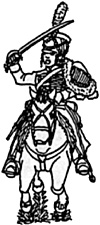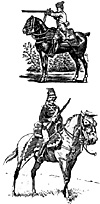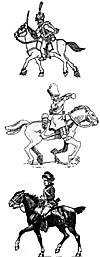 Pickets
Pickets
A picket screen is a series of outposts of an army that has two major jobs:
- 1. As an early warming system for the encamped army. Any enemy advance will make contact with the picket screen first, which should be able to raise the alarm with enough time for the troops to fall into position to avoid being surprised.
2. As a screen to prevent the enemy from engaging in any reconnaissance close to the army and gathering detailed information about where units are concentrated.
Scouting parties would often need to engage with the enemy pickets to break through their line and view the army behind. It is this lack of information and searching for the enemy that I wanted to recreate in my solo campaigns. Through this I have devised these rules for solo skirmish games between pickets and scouts.
Pickets on the local campaign map
Having established that opposing armies are entering the same hex on the strategic campaign map the action moves to the local campaign map. This is an enlargement of the strategic map hex with each hex representing about a mile. At this stage I represent my forces by divisions and the enemy forces as line representing their front line of pickets. Behind this line is the enemy army, which I represent with ‘fog’! (See map). If the line of pickets is successfully penetrated then the enemy force in that sector is revealed to me. The only other time that the enemy force is revealed is when a division becomes adjacent to the ‘fog’. When this happens the enemy forces are revealed and both sides are placed on the wargames table to fight out the action. Obviously it is better to know what you are up against before you move into a position where a battle will be forced upon you.
Each of my divisions can send out a strong force of scouts into one adjacent hex in any direction or a weak force of scouts into any hex two hexes away from the division. The composition of the scouts (cavalry or infantry) must reflect the make up of the division from which they came. When the scouts come into the same hex as the enemy pickets you can choose to try and push through their picket line for reconnaissance. A skirmish game is then put together to represent the fight between the scouts and pickets. If one of your figures succeeds in crossing the board to the enemy base line and returning unharmed then the enemy force for that part of the battlefield is revealed.
The skirmish game
The table below shows how many points for scouts you have. I used a simple factor of one point is required for an infantry scout and two points are required for a cavalry scout. The proportion of cavalry to infantry should reflect the composition of the division from which they were drawn.
| D6 score | 1 | 2 | 3 | 4 | 5 | 6 |
|---|---|---|---|---|---|---|
| Strong scout force | 10 pt. | 12 pt. | 14 pt. | 16 pt. | 18 pt. | 20 pt. |
| Weak scout force | 2 pt. | 3 pt. | 4 pt. | 5 pt. | 6 pt. | 7 pt. |
The enemy picket force will usually be stronger than your scouts (to give you a challenging game!) and will be a mixed force of infantry and cavalry.
Throw one D6 to find out the size of their infantry force and one D6 for the cavalry component. The numbers represent infantry or cavalry figures this time rather than points.
| D6 score | 1 | 2 | 3 | 4 | 5 | 6 |
|---|---|---|---|---|---|---|
| Infantry | 10 | 12 | 14 | 16 | 18 | 20 |
| Cavalry | 2 | 4 | 6 | 8 | 10 | 12 |
 Position of enemy pickets
Position of enemy pickets
These are placed randomly at appropriate positions of cover such as buildings, woods, hedgerows, ditches, etc. Also any roads, railways or waterways will have a guard with some kind of barrier or obstacle.
Only half of the available enemy pickets are placed, the rest are considered unobserved as yet.
Chance of pickets reacting
From what I have read it generally seems that pickets are after a quiet life and as long as their opponents do nothing to disturb them then they will let the enemy wander around in front of them. So at long range nothing is going to happen but if enemy pickets are approached and the distances are reduced to medium range or less the pickets may get nervous and open fire.
Throw a D6 to see the reaction as pickets are approached:
- Distance from enemy pickets Chance that enemy will open fire
Medium range D6: 5-6 = open fire.
Short range D6: 2-6 = open fire.
If you fire first then the enemy will automatically respond with firing.
Enemy reactions once engaged
For each enemy picket that starts firing throw a D6 to find out what support he has available. If the picket has support take figures from those unused in the initial deployment and place them on the table in appropriate places.
- D6 score Support for picket.
1 There are two others with the picket.
2 There is one other with the picket and one in support to the rear.
3 There are two other pickets in support to the rear.
4 There is one picket in support to the rear.
5 A movement is spotted: place a marker in some randomly selected cover. This could be a scared or sleeping picket or a farm animal!
6 No support.
 If a marker has been placed to represent a scared or sleeping picket / farm animal this will only be exposed if you troops actually enter the place where the marker is placed or if troops approach to close range and a D6 score of 6 is achieved. Then it is a picket and has opened fire; dice for support. If the marker is over run then check to see what it is:
If a marker has been placed to represent a scared or sleeping picket / farm animal this will only be exposed if you troops actually enter the place where the marker is placed or if troops approach to close range and a D6 score of 6 is achieved. Then it is a picket and has opened fire; dice for support. If the marker is over run then check to see what it is:
- D6 score Marker becomes …
1 or 2 … a picket angry at being woken and furiously fighting.
3 … a hiding picket that surrenders as the troops approach.
4 … a scared picket hiding in the undergrowth; leave the marker.
5 or 6 … sheep grazing in the cover.
Once enemy pickets are fighting throw 2 x D6 dice to see what each picket or picket group will do. Make the following additions and subtractions to the score then consult the table.
- -1 if the picket(s) is/are being fired on or directly attacked by twice as many men.
-2 if the picket(s) is/are being fired on or directly attacked by three times as many men.
-3 if the picket(s) is/are being fired on or directly attacked by four times as many men. Etc.
+1 if the picket(s) is/are being fired on or directly attacked by half as many men.
+2 if the picket(s) is/ are being fired on or directly attacked by a quarter as many men. Etc.
2D6+/- Picket(s) action
- 2 Runs back to lines as quickly as possible.
3 Retreats to next cover position.
4 Retreats back to nearest picket in the rear.
5 Moves to nearest picket and operate together.
6 Holds position.
7 Moves only if able to gain better cover or better shooting.
8 Joins any advance made by other pickets.
9 Advances slowly making use of cover.
10 Advances rapidly making use of cover.
11 Aims to advance past enemy and encircle them.
12 Charges the enemy.
If one of your figures succeeds in crossing the board to the enemy base line and returning unharmed then the enemy force for that part of the battlefield is revealed. However if the scout force suffers 50% or more casualties then the scout force for that division disintegrates and you can not organise a new scout force until the following day.
Other scouting factors
There are other methods of spotting the position of enemy troops are these can be incorporated into the campaign rules. Hills, church spires, balloons can all give a height advantage enabling scouts to look over picket screens and view the army behind. Limiting factors to using these methods also need to be considered such as low cloud, heat haze or dust clouds from moving troops. Spies and information from prisoners and locals may also bring valuable information. The capture (and following interrogation) of two prisoners in a skirmish could negate the need to break through the enemy skirmish line.
Ideas for ‘hiding’ armies
These ideas will only be of use if you have some method of concealing the enemy’s army positions. This could be done on a probability system with a high probability given to the likely position of enemy troops and low probability given to unusual or risky positions. Another method is to use cards or counters, some representing real units with others being fakes. The real and fake units are not revealed, until they are viewed by scouts or encountered on the battlefield.
Back to Table of Contents -- Lone Warrior # 142
Back to Lone Warrior List of Issues
Back to MagWeb Magazine List
© Copyright 2003 by Solo Wargamers Association.
This article appears in MagWeb.com (Magazine Web) on the Internet World Wide Web.
Other military history articles and gaming articles are available at http://www.magweb.com
